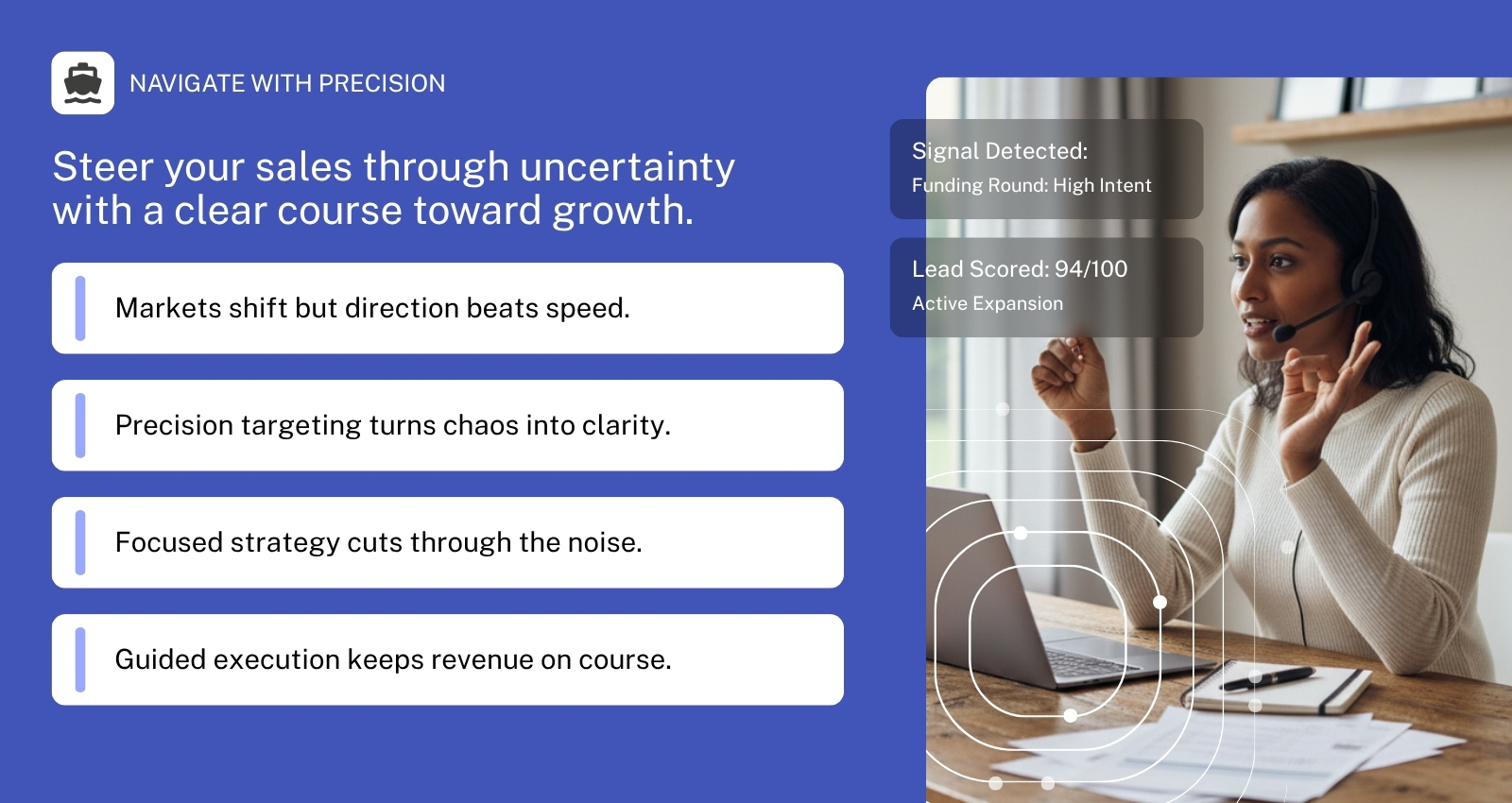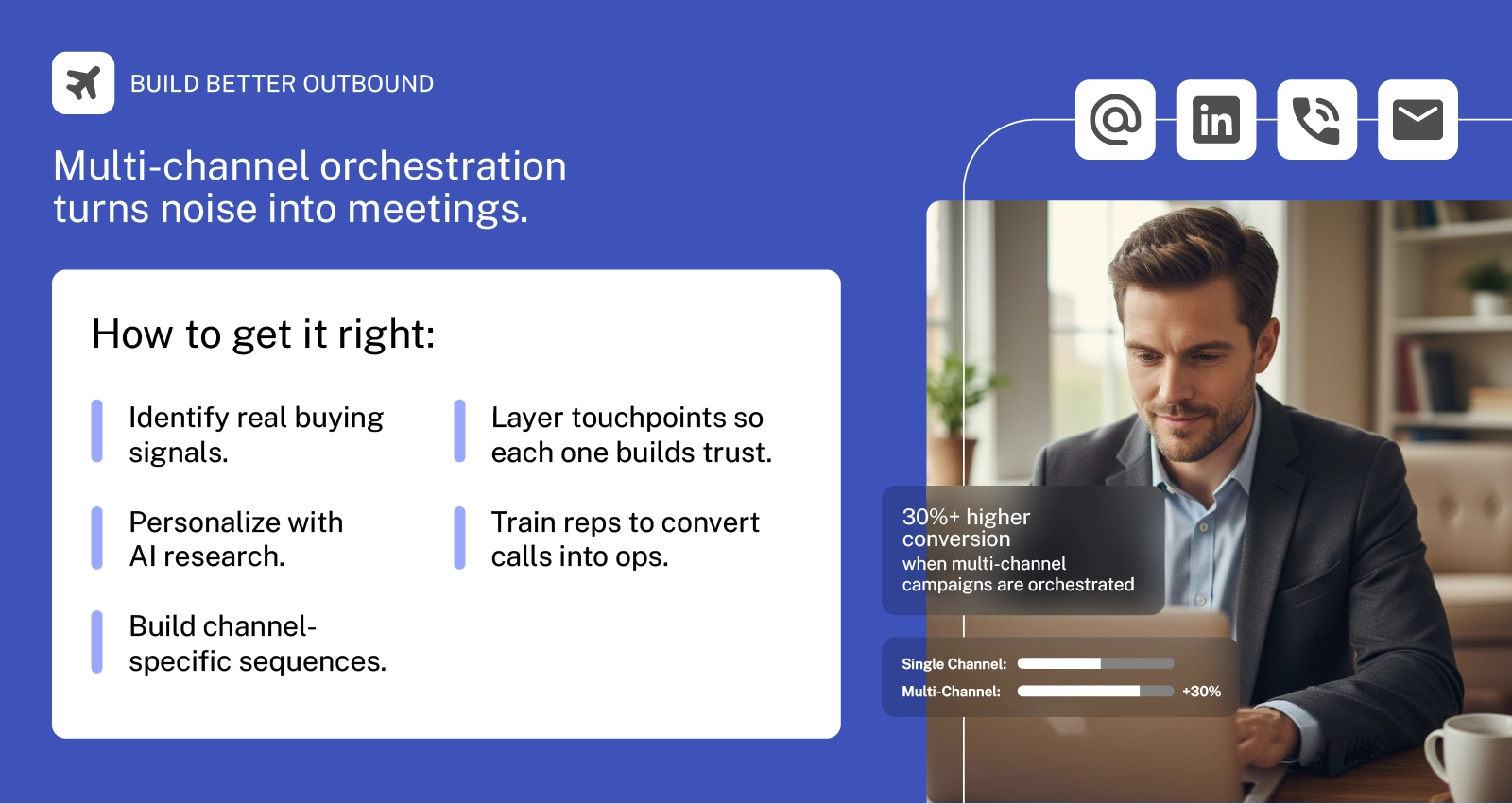

Use This Framework To Master Discovery Calls for Outbound Leads
[blog_at_glance]
Hurrah! Your outbound efforts have been paying off and you have introductory meetings booked in left, right and centre.
Now, it’s your job to make sure these outbound prospects turn into deals won, and your first opportunity to wow your prospect is fast approaching. But how confident are you that your discovery call (DC) approach will ensure you get those deals across the line?
Table of contents
- Why you need a new approach for outbound leads
- So, what exactly is the S.C.A.L.E framework?
- S - Seek
- C - Clarify
- A - Ask
- L - Link
- E - Engage
- After running the framework
Why you need a new approach for outbound leads
If you're using the same approach for outbound and inbound leads, or worse yet, you have no agenda, you could be waving outbound prospects goodbye.
Why do you need a clear outbound DC framework?
- A structured call will reduce time wasting
- It increases the chances of building trust with your prospects
- You have a higher chance of uncovering their pain points
- It’s likely to accelerate your sales process
- There’s a chance you can create a desire for your product without it pre-existing
- You can reduce pipeline drop off
Research by Forrester found that deals where the sales rep thoroughly understood the buyer's needs and challenges (through effective discovery) were 67% more likely to result in a closed-won opportunity.
If you’re running discovery calls with only a vague list of questions to guide you - you’re likely letting potential revenue walk out the door. Engaging prospects through outbound efforts requires a strategic approach.
While there are many blueprints for discovery calls floating around on the web, the majority do not take into account the prospect type (inbound or outbound). We've developed our own framework that is based on over 10 years of hands-on experience. Our S.C.A.L.E. framework for outbound leads has been developed to help you navigate discovery calls with finesse.
The SCALE framework strikes the perfect balance between gathering insights and sharing valuable knowledge, allowing you to build trust and lay the foundation for a fruitful partnership.
So, what exactly is the S.C.A.L.E framework?
Let’s break it down.
S - Seek

What does this mean?
Start by asking questions that uncover their most pressing challenges and objectives. It's about painting a holistic picture of their world.
Example:
- "What are your priorities right now, and what are the biggest challenges you're facing related to XYZ?"
- "What are the biggest obstacles or roadblocks you're currently facing in achieving those goals?"
- "How do those goals tie into the broader company vision or objectives?"
Why?
C - Clarify

What does this mean?
Restating the identified challenges in your own words shows you understand them and validates that you're both on the same page before moving forward.
Example:
- "Got it, so to clarify, your biggest priority right now is XYZ, and the challenge you're facing is XYZ."
- "If I'm understanding correctly, one of your biggest priorities is [XYZ goal], but you're struggling with [XYZ challenge] which is preventing you from making progress. Is that right?"
Why?
Mirroring their responses back to them will show you are actively listening, clarifies their challenges and validates their responses. They will not only feel that you truly understand them, but it can lower their psychological defences and make them more open to your suggestions or proposals.
A - Ask

What does this mean?
Don't just take their initial explanation at face value. Dig deeper to uncover root causes, compounding factors, and nuances of the challenge.
Example:
- "How long has this been a persistent problem for you?"
- "What have you tried so far?
- “How did that work out?”
- “How long did you try it for?
- “What else have you tried?
- “How did that go?"
- "Why do you think previous attempts to solve it were unsuccessful?"
Why?
By uncovering the root causes and nuances of the prospect's challenge, you demonstrate your commitment to understanding and addressing the real problem they are facing, rather than just treating surface-level symptoms. This builds trust and credibility, as the prospect perceives you as someone who truly wants to help them, rather than just pushing a product or service.
L - Link

What does this mean?
Introduce your solution by highlighting its key pillars and how they directly address the identified pain points. Use the "three key pillars" tool to tailor your pitch to the prospect's unique needs. This means, highlighting three specific ways your product/service philosophy and approach aligns with addressing their clarified challenges.
Why?
By using tailored messaging, similar language and personalised examples in your value proposition, you are increasing resonance with your prospect. They are less likely to dismiss your offering as irrelevant or unsuitable when they recognize that you have taken the time to understand their specific requirements and have crafted a solution with their needs in mind.
E - Engage

What does this mean?
Solidify your position as an expert by sharing a success story that demonstrates how you've helped similar companies overcome comparable challenges.
Why?
Case studies largely help by reducing scepticism and perceived risk in your prospects. They will feel more comfortable that you can address their challenges when they know you have done it successfully before. It can also be aspirational for them, which increases their motivation to follow through on the buyer journey.
The 'L' and the 'E' within SCALE is essentially your sales pitch. It's going to be unique for each prospect
After running the framework
If you’ve successfully used S.C.A.L.E., you’ve opened up the discussion and set the scene for follow up questions, without the risk of sounding like you’re interrogating your prospect.
If you feel that you’ve managed to build some rapport, a key question to ask towards the end of the discussion is “who else is involved in the decision making process”. Building a better understanding of all the moving parts involved to get the deal across the line is going to be very beneficial for you later in the buyer journey.
Finally, remember that it’s crucial to now keep the momentum going that you’ve just created. Your prospect should be engaged at the end of this call and it’s your job to ensure they are moved as seamlessly as possible through their buyer journey. With this in mind, it’s essential that you secure a date for the next call at the end of every call. Including it in your call avoids an email chase and leaves the prospect with clarity about their next steps.



“My priority is ensuring we have the right strategy and culture in place to achieve the company vision”
[blog_at_glance]
Hurrah! Your outbound efforts have been paying off and you have introductory meetings booked in left, right and centre.
Now, it’s your job to make sure these outbound prospects turn into deals won, and your first opportunity to wow your prospect is fast approaching. But how confident are you that your discovery call (DC) approach will ensure you get those deals across the line?
Table of contents
- Why you need a new approach for outbound leads
- So, what exactly is the S.C.A.L.E framework?
- S - Seek
- C - Clarify
- A - Ask
- L - Link
- E - Engage
- After running the framework
Why you need a new approach for outbound leads
If you're using the same approach for outbound and inbound leads, or worse yet, you have no agenda, you could be waving outbound prospects goodbye.
Why do you need a clear outbound DC framework?
- A structured call will reduce time wasting
- It increases the chances of building trust with your prospects
- You have a higher chance of uncovering their pain points
- It’s likely to accelerate your sales process
- There’s a chance you can create a desire for your product without it pre-existing
- You can reduce pipeline drop off
Research by Forrester found that deals where the sales rep thoroughly understood the buyer's needs and challenges (through effective discovery) were 67% more likely to result in a closed-won opportunity.
If you’re running discovery calls with only a vague list of questions to guide you - you’re likely letting potential revenue walk out the door. Engaging prospects through outbound efforts requires a strategic approach.
While there are many blueprints for discovery calls floating around on the web, the majority do not take into account the prospect type (inbound or outbound). We've developed our own framework that is based on over 10 years of hands-on experience. Our S.C.A.L.E. framework for outbound leads has been developed to help you navigate discovery calls with finesse.
The SCALE framework strikes the perfect balance between gathering insights and sharing valuable knowledge, allowing you to build trust and lay the foundation for a fruitful partnership.
So, what exactly is the S.C.A.L.E framework?
Let’s break it down.
S - Seek

What does this mean?
Start by asking questions that uncover their most pressing challenges and objectives. It's about painting a holistic picture of their world.
Example:
- "What are your priorities right now, and what are the biggest challenges you're facing related to XYZ?"
- "What are the biggest obstacles or roadblocks you're currently facing in achieving those goals?"
- "How do those goals tie into the broader company vision or objectives?"
Why?
C - Clarify

What does this mean?
Restating the identified challenges in your own words shows you understand them and validates that you're both on the same page before moving forward.
Example:
- "Got it, so to clarify, your biggest priority right now is XYZ, and the challenge you're facing is XYZ."
- "If I'm understanding correctly, one of your biggest priorities is [XYZ goal], but you're struggling with [XYZ challenge] which is preventing you from making progress. Is that right?"
Why?
Mirroring their responses back to them will show you are actively listening, clarifies their challenges and validates their responses. They will not only feel that you truly understand them, but it can lower their psychological defences and make them more open to your suggestions or proposals.
A - Ask

What does this mean?
Don't just take their initial explanation at face value. Dig deeper to uncover root causes, compounding factors, and nuances of the challenge.
Example:
- "How long has this been a persistent problem for you?"
- "What have you tried so far?
- “How did that work out?”
- “How long did you try it for?
- “What else have you tried?
- “How did that go?"
- "Why do you think previous attempts to solve it were unsuccessful?"
Why?
By uncovering the root causes and nuances of the prospect's challenge, you demonstrate your commitment to understanding and addressing the real problem they are facing, rather than just treating surface-level symptoms. This builds trust and credibility, as the prospect perceives you as someone who truly wants to help them, rather than just pushing a product or service.
L - Link

What does this mean?
Introduce your solution by highlighting its key pillars and how they directly address the identified pain points. Use the "three key pillars" tool to tailor your pitch to the prospect's unique needs. This means, highlighting three specific ways your product/service philosophy and approach aligns with addressing their clarified challenges.
Why?
By using tailored messaging, similar language and personalised examples in your value proposition, you are increasing resonance with your prospect. They are less likely to dismiss your offering as irrelevant or unsuitable when they recognize that you have taken the time to understand their specific requirements and have crafted a solution with their needs in mind.
E - Engage

What does this mean?
Solidify your position as an expert by sharing a success story that demonstrates how you've helped similar companies overcome comparable challenges.
Why?
Case studies largely help by reducing scepticism and perceived risk in your prospects. They will feel more comfortable that you can address their challenges when they know you have done it successfully before. It can also be aspirational for them, which increases their motivation to follow through on the buyer journey.
The 'L' and the 'E' within SCALE is essentially your sales pitch. It's going to be unique for each prospect
After running the framework
If you’ve successfully used S.C.A.L.E., you’ve opened up the discussion and set the scene for follow up questions, without the risk of sounding like you’re interrogating your prospect.
If you feel that you’ve managed to build some rapport, a key question to ask towards the end of the discussion is “who else is involved in the decision making process”. Building a better understanding of all the moving parts involved to get the deal across the line is going to be very beneficial for you later in the buyer journey.
Finally, remember that it’s crucial to now keep the momentum going that you’ve just created. Your prospect should be engaged at the end of this call and it’s your job to ensure they are moved as seamlessly as possible through their buyer journey. With this in mind, it’s essential that you secure a date for the next call at the end of every call. Including it in your call avoids an email chase and leaves the prospect with clarity about their next steps.















